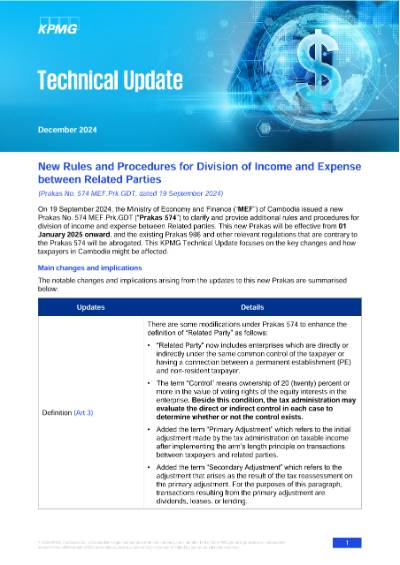New Rules and Procedures for Division of Income and Expense between Related Parties
(Prakas No. 574 MEF.Prk.GDT, dated 19 September 2024)
On 19 September 2024, the Ministry of Economy and Finance (“MEF”) of Cambodia issued a new Prakas No. 574 MEF.Prk.GDT (“Prakas 574”) to clarify and provide additional rules and procedures for division of income and expense between Related parties. This new Prakas will be effective from 01 January 2025 onward, and the existing Prakas 986 and other relevant regulations that are contrary to the Prakas 574 will be abrogated. This KPMG Technical Update focuses on the key changes and how taxpayers in Cambodia might be affected.
Main changes and implications
The notable changes and implications arising from the updates to this new Prakas are summarised below:
| Updates | Details |
| Definition (Art.3) | There are some modifications under Prakas 574 to enhance the definition of “Related Party” as follows: • “Related Party” now includes enterprises which are directly or indirectly under the same common control of the taxpayer or having a connection between a permanent establishment (PE) and non-resident taxpayer. • The term “Control” means ownership of 20 (twenty) percent or more in the value of voting rights of the equity interests in the enterprise. Beside this condition, the tax administration may evaluate the direct or indirect control in each case to determine whether or not the control exists. • Added the term “Primary Adjustment” which refers to the initial adjustment made by the tax administration on taxable income after implementing the arm’s length principle on transactions between taxpayers and related parties. • Added the term “Secondary Adjustment” which refers to the adjustment that arises as the result of the tax reassessment on the primary adjustment. For the purposes of this paragraph, transactions resulting from the primary adjustment are dividends, leases, or lending. • Added the term “Median” which refers to the value that lies in the middle of an ordered data set that goes from lowest to highest. If the value of a data set is odd, the number in the middle is the median. If the value of a data set is even, then the median is the average of the middle two numbers. |
| Arm’s length range (Art.7) | This Article added that financial indicators in a controlled transaction that is outside arm’s range will be adjusted according to the median of the arm’s length range only if there is no reduction or loss of tax. |
| Documentation [Art.17 (4)] – Contemporaneous TP documentation | This Article added that for taxpayers that have already prepared the Transfer Pricing (TP) Documentation for the previous tax year, the latest documents can be used in the current tax year in the case where there are no changes in the characteristics of the controlled transactions and the comparability analysis that would affect the TP methods applied. However, the financial indicators data of the taxpayers and independent comparable companies should be updated every year in the TP report. |
| Documentation [Art.17 (5)] – Exemption from arm’s length for loans (existing regulations) | Loan transactions from related parties are exempt from the application of the arm’s length principle where the taxpayers have documentation verifying the interest rate set detailed by Instruction from the General Department of Taxation (GDT). |
| Documentation [Art.17 (6)] – Exemption from TP documentation for loans (new update) | Resident taxpayers that are not banks or microfinance institutions, are exempt from the implementation of the arm’s length principle for loans from related parties and are not required to prepare documentation verifying the interest between related parties as stated in paragraph 5 of this article, if the taxpayer meets either one of the following criteria: a. Is an enterprise that has been established for less than three years from the date of tax registration; or b. Is a single member private limited company and has loan transactions from its owner with a balance at any time of less than 3,000,000,000 (three billion) riel; or c. Is a sole proprietorship that has loan transactions from the owner, spouse, or dependent child. |
| Documentation [Art.17 (7)] – Exemption from TP documentation for general transactions except from loans | Taxpayers are exempt from the obligation to prepare Transfer Pricing Documentation for any tax year, as stated in paragraph 2 of this article, if the taxpayer meets both criteria within that tax year as follows: a. Has an annual turnover of less than 8,000,000,000 (eight billion) riel and total assets of less than 4,000,000,000 (four billion) riel, and b. Has related party transactions of a total value of less than 1,000,000,000 (one billion) riel for goods, properties, or services and royalties, including other related transactions. This limit excludes any related party loan transactions. |
| Attribution of Profits to PE (Art.18) | 1. In the case where a non-resident taxpayer has a PE in the Kingdom of Cambodia, the taxpayer must attribute gross income, deductions, or other benefits clearly reflecting the income between the PE and the non-resident taxpayer. 2. For the purposes of paragraph 1 of this article, taxable income derived from the PE and the nonresident taxpayer shall be determined as the taxable income of independent and separate enterprises engaged in similar or comparable business activities under similar or comparable conditions, including income from the provision of goods or services similar or comparable to those of the PE that the non-resident taxpayer has provided within the Kingdom of Cambodia. |
| Penalties (Art.19) | There is a significant increase in fines and penalties imposed upon the obstruction of the implementation of tax provisions in accordance with the 2023 Law on Taxation (2023 LoT). |
Our comments
In general, the new Prakas 574 provides clearer guidance on the rules and procedures for the division of income and expenses of business transactions between related parties compared to the previous Prakas No. 986. In addition, various new provisions have been added into this new Prakas which are of significant value to the smaller taxpayer, particularly the determination of the “safe harbor” rule for the exemption from the obligation of preparing TP Documentation as stated in Article 17 “Documentation” which reduces the burden of further tax compliance for those taxpayers.
The new additional provision under the definition of “Related Party” relating to the term “control” as stated under Article 3 will give a wider power to the GDT to interpret what is “control” more broadly and potentially result in more transactions being determined as related party transactions. The interpretation of this provision will need to be monitored and specific rules on the “substance over form” principle and guidance should be further clarified from the GDT.
It should be noted that the penalty provision as mentioned under Article 19 of this new Prakas aligns with the penalty provision in the 2023 LoT which is much more onerous, especially for those taxpayers who have significant related party transactions (RPTs) with lack of proper supporting TP Documentation.
We have seen an increase in the review level of the GDT in respect of RPTs in the event of the tax audits. With the introduction of this new Prakas, we believe that the GDT will continue to focus its tax audit on RPTs as they could potentially lead to a distortion of the tax liabilities of the resident companies in Cambodia, and result in a distortion of the tax revenue of the government, i.e. loss to the State Budget if the RPT’s are not undertaken within the “arms-length” principle.
To mitigate the impact of having the GDT determine that an adjustment of RPTs is appropriate, we strongly advise taxpayers to undertake a review of current and proposed RPTs to ensure that all appropriate steps are taken to mitigate any tax risks. Taxpayers need to consider having available TP Documentation as stated in the Article 19 of this new Prakas and this documentation must be available to be provided to the GDT as required. In the absence of the required TP Documentation, the GDT can impose TP adjustments which could result in additional taxes and penalties, potentially now including the penalties on obstruction.
In addition, if GDT considers the matter to be a serious case the tax administrative may pursue criminal charges. The use of these extended penalty provisions will need to be monitored closely following implementation.
How we can help
As committed tax advisors to our clients, we welcome any opportunities to discuss the relevance of the above matters to your business.
Connect with us
- Find office locations kpmg.findOfficeLocations
- kpmg.emailUs
- Social media @ KPMG kpmg.socialMedia


